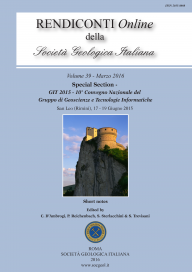
Tools for structural geology analysis in QGIS
Mauro Alberti (a), Martin Laloux (b) & Marco Zanieri (c)
(a) OverIT S.p.A., Strada Due, Palazzo D3 20090 Assago Milanofiori (MI), Italy. E-mail: alberti.m65@gmail.com
(b) Earth and Life Institute, Université Catholique de Louvain, Croix du Sud 2/L7.05.10, 1348 Louvain-la-Neuve, Belgium. E-mail: martin.laloux@uclouvain.be
(c) Via Don Pio Vannucchi n.5, 59100 Prato (PO), Italy. E-mail: marcozanieri@gmail.com
Volume: 39/2016
Pages: 55-59
Abstract
QGIS is a free and open source GIS software that is highly customizable through the use of Python scripts. We examine the available tools for structural geology analysis. The common basis of all these tools is constituted by scientific and also visualization modules, like NumPy, SciPy and Matplotlib. A few structural geology Python modules exist, the most notable being Apsg by Ondrej Lexa. It allows manipulating orientation data and presents convenience functions for plotting them in Matplotlib stereonets. Based on these scientific, geologic and visualization modules it is possible to produce scripts or processing plugins for crosssection preparation, attitude interpolations on regular grids and stereonet plotting. Plugins based on Qt GUI are just a few, devoted to the analysis of the relations between geological plane traces and topographic surfaces (qgSurf plugin), to the preparation of cross-sections with projection of geological attitudes and intersection of geological traces or polygons (qProf plugin), management of hydrological data (Midvatten plugin) or digitalization of fractures and other lineaments from referenced digital photos (digiFract plugin).
Keywords
Get Full Text